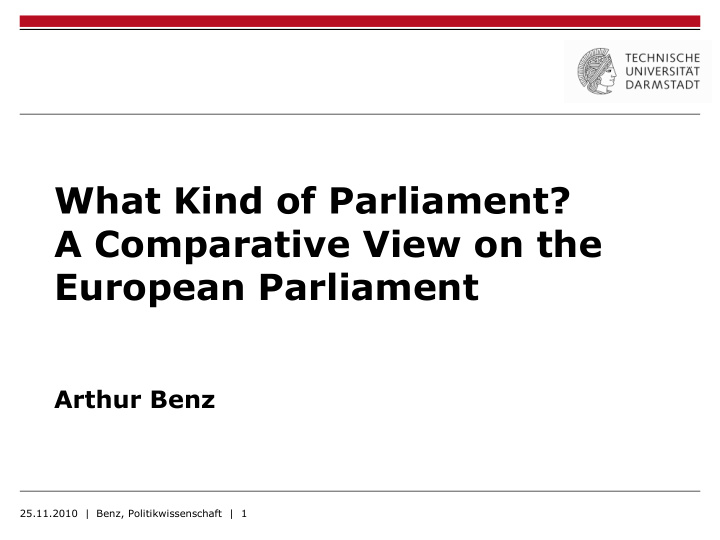



What Kind of Parliament? A Comparative View on the European Parliament Arthur Benz 25.11.2010 | Benz, Politikwissenschaft | 1
Basic structure: A parliament like others? Functions : Co-election of commission Co-legislation Control Public debate Organization : Plenary President, Conference of Presidents Party groups Committees Decision rules : simple or absolute majority of votes/members 25.11.2010 | Benz, Politikwissenschaft | 2
A changing institution before 1979: Assembly of delegates of national parliaments 1979: election of European Parliament: a deliberating institution Since 1986: extension of legislative powers, co-decision procedures Enlargement: growing number of seats, national groups Evolution of a European party system Dynamics of inter-institutional politics Multilevel politics Lisbon Treaty: a new balance of power 25.11.2010 | Benz, Politikwissenschaft | 3
EP compared to Westminster system no European government responsible to the EP no duality between majority and opposition limited party discipline increasing role of parties, but fragmented party system crosscutting lines of conflicts 25.11.2010 | Benz, Politikwissenschaft | 4
EP compared to US Congress Two legislative “chambers”, with different (supranational and intergovernmental) modes of decision-making no president as counterpart, no clear division of powers less influence of local electorate multilevel party system: incongruent, less integrated 25.11.2010 | Benz, Politikwissenschaft | 5
EP in a particular consensus democracy Consensus between legislative institutions increasing need for joint decision-making with the Council of Ministers and the Commission Lisbon Treaty: “Co - decision” as ordinary legislative procedure Consensus inside the European Parliament “Political balance” (proportionality) between party groups 25.11.2010 | Benz, Politikwissenschaft | 6
Ordinary legislative procedure Initiative by Commission 1st reading if EP and Council agree, act is adopted if EP and Council do not agree → 2nd reading, based on Council position amendments required by EP (majority of seats) → qualified majority in the Council in case of disagreement: Conciliation procedure 25.11.2010 | Benz, Politikwissenschaft | 7
EP-Council agreements Source: http://ec.europa.eu/codecision/statistics/docs/report_statistics_public_draft_en.pdf 25.11.2010 | Benz, Politikwissenschaft | 8
EP in a particular consensus democracy issue specific negotiations of majorities legislation as committee work powerful rapporteurs, selected by parties, but specialized in policy fields less deliberation more bargaining 25.11.2010 | Benz, Politikwissenschaft | 9
Inter-parliamentary relations Subsidiarity control: Coordination with national parliaments inter-institutional agreement with Commission: Cooperation on legislative initiatives presumably strengthening of national groups in EP 25.11.2010 | Benz, Politikwissenschaft | 10
Conclusion Three basic trends increasing power of EP party politics Enlargement, multilevel parliaments national diversity Inter-institutional coordination; inter-parliamentary relations specialisation (committees; rapporteurs) fluctuating, cross- cutting “policy coalitions” non-hierarchical structure in party groups considerable extent of informality importance of inter-institutional cooperation 25.11.2010 | Benz, Politikwissenschaft | 11
More recommend